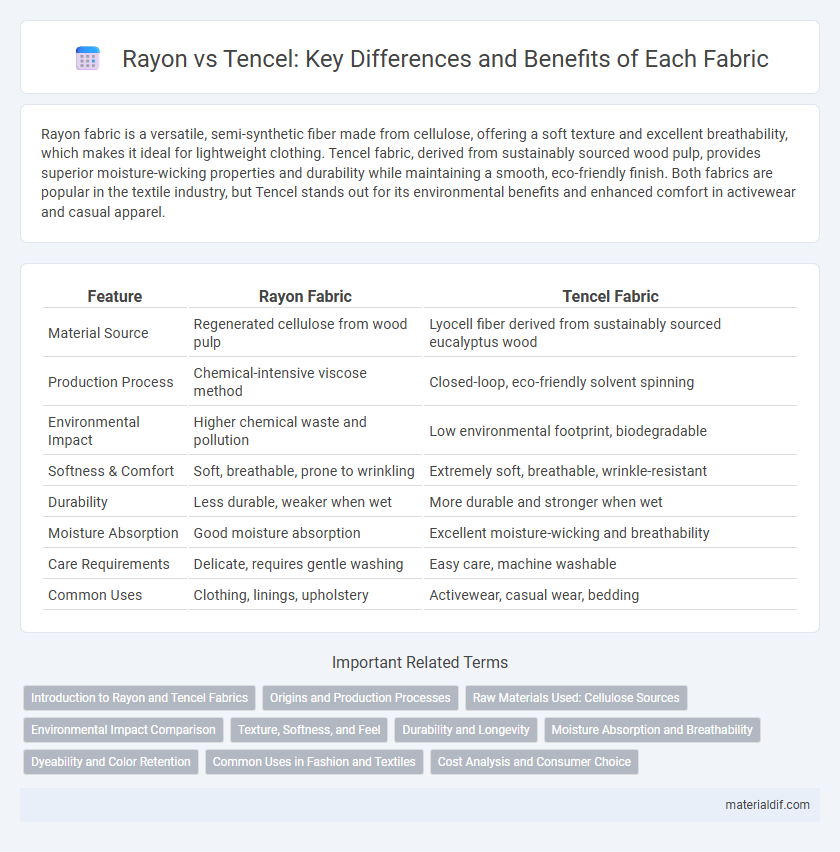Rayon fabric is a versatile, semi-synthetic fiber made from cellulose, offering a soft texture and excellent breathability, which makes it ideal for lightweight clothing. Tencel fabric, derived from sustainably sourced wood pulp, provides superior moisture-wicking properties and durability while maintaining a smooth, eco-friendly finish. Both fabrics are popular in the textile industry, but Tencel stands out for its environmental benefits and enhanced comfort in activewear and casual apparel.
Table of Comparison
| Feature | Rayon Fabric | Tencel Fabric |
|---|---|---|
| Material Source | Regenerated cellulose from wood pulp | Lyocell fiber derived from sustainably sourced eucalyptus wood |
| Production Process | Chemical-intensive viscose method | Closed-loop, eco-friendly solvent spinning |
| Environmental Impact | Higher chemical waste and pollution | Low environmental footprint, biodegradable |
| Softness & Comfort | Soft, breathable, prone to wrinkling | Extremely soft, breathable, wrinkle-resistant |
| Durability | Less durable, weaker when wet | More durable and stronger when wet |
| Moisture Absorption | Good moisture absorption | Excellent moisture-wicking and breathability |
| Care Requirements | Delicate, requires gentle washing | Easy care, machine washable |
| Common Uses | Clothing, linings, upholstery | Activewear, casual wear, bedding |
Introduction to Rayon and Tencel Fabrics
Rayon fabric, a semi-synthetic fiber derived from cellulose, is renowned for its smooth texture and breathability, making it a popular choice in apparel and home textiles. Tencel fabric, produced from sustainably sourced wood pulp through a closed-loop process, offers enhanced moisture-wicking properties and exceptional softness compared to traditional rayon. Both fabrics are biodegradable and versatile but differ in environmental impact and durability, with Tencel often favored for eco-conscious textile manufacturing.
Origins and Production Processes
Rayon fabric, derived from cellulose primarily extracted from wood pulp, undergoes a chemical-intensive process involving viscose or cuprammonium methods to regenerate fibers. Tencel fabric, branded as lyocell, is produced from sustainably sourced eucalyptus trees using a closed-loop solvent spinning process that minimizes environmental impact by recycling water and solvents. Both fabrics share cellulose origins but differ fundamentally in their production techniques and eco-friendly credentials.
Raw Materials Used: Cellulose Sources
Rayon fabric is primarily derived from wood pulp cellulose obtained from hardwood trees such as beech, pine, and eucalyptus, whereas Tencel fabric utilizes sustainably sourced eucalyptus wood treated with environmentally friendly processes. Both fabrics rely on natural cellulose fibers, but Tencel emphasizes closed-loop production methods that recycle water and solvents, reducing environmental impact. The choice between rayon and Tencel depends on the specific cellulose source and the sustainability of the raw material harvesting and processing techniques.
Environmental Impact Comparison
Rayon fabric production involves significant chemical processing and high water usage, leading to deforestation and pollution concerns. In contrast, Tencel fabric, made from sustainably sourced wood pulp via closed-loop processing, minimizes waste and reduces environmental footprint. Tencel's biodegradable nature and lower carbon emissions position it as a more eco-friendly alternative to traditional rayon fabric.
Texture, Softness, and Feel
Rayon fabric offers a smooth, silky texture with moderate softness, providing a lightweight and breathable feel ideal for warm climates. In comparison, Tencel fabric is known for its superior softness and silky-smooth surface resulting from its eco-friendly production process, delivering a cooler and more moisture-wicking experience. Both fabrics drape well, but Tencel's natural fibers enhance its gentle feel against the skin, making it preferred for sensitive skin and high-performance comfort garments.
Durability and Longevity
Rayon fabric typically exhibits moderate durability, prone to weakening when wet and showing signs of wear over time due to its semi-synthetic cellulose fibers. Tencel fabric, derived from sustainably sourced wood pulp, offers superior longevity with enhanced strength and resistance to wrinkles, making it more resilient in everyday use. The advanced fiber technology in Tencel contributes to better retention of shape and color, extending the lifespan of garments compared to traditional rayon.
Moisture Absorption and Breathability
Rayon fabric, derived from regenerated cellulose fibers, offers good moisture absorption, making it comfortable in warm and humid conditions. Tencel fabric, produced from sustainably sourced eucalyptus wood pulp, excels in moisture-wicking and breathability due to its unique fiber structure, which promotes better airflow and faster drying times. Both fabrics provide comfort, but Tencel's superior breathability and eco-friendly production make it preferable for moisture management in activewear and sensitive skin applications.
Dyeability and Color Retention
Rayon fabric exhibits excellent dyeability due to its cellulose-based fibers, allowing for vibrant and diverse color options with strong absorption rates. Tencel fabric, derived from sustainable wood pulp, also offers good dyeability but often results in more muted tones as its fibers retain dye differently, emphasizing color depth over brightness. When it comes to color retention, rayon tends to fade faster due to weaker fiber structure, whereas Tencel maintains color integrity longer, benefiting from its enhanced fiber durability and moisture-wicking properties.
Common Uses in Fashion and Textiles
Rayon fabric is widely used for casual wear, linings, and drapery due to its silky texture and breathability, making it ideal for summer clothing and decorative textiles. Tencel fabric, derived from sustainably sourced wood pulp, is favored in activewear, eco-friendly fashion, and high-end garments for its moisture-wicking properties and durability. Both fabrics serve versatile roles in fashion, but Tencel's environmental benefits and performance features make it a preferred choice in sustainable textile production.
Cost Analysis and Consumer Choice
Rayon fabric generally costs less than Tencel due to its simpler production process and widespread manufacturing, appealing to budget-conscious consumers seeking affordable, breathable textiles. Tencel, derived from sustainably managed eucalyptus trees through an eco-friendly closed-loop process, commands a higher price, attracting environmentally aware buyers valuing durability and moisture management. Consumer choice hinges on balancing upfront costs against sustainability priorities and long-term fabric performance in clothing or home textiles.
Rayon Fabric vs Tencel Fabric Infographic

 materialdif.com
materialdif.com